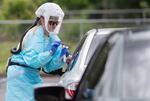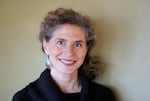When Jennifer Arnold’s work phone rings, she never knows what she’ll hear coming from the other end.
Sometimes it’s someone calling to ask about COVID-19 symptoms. Sometimes the caller wants to know how to get tested. Sometimes it’s someone who knows they have COVID-19 and aren’t sure what to do next.
And sometimes the person on the other end of the line is so full of virus, she can hear them struggling to breathe.
“Your instincts kick in, your clinical evaluation skills kick in, and you realize this patient needs care. They don’t just need a test, they need to handle this now,” said Arnold, who works as a nurse at Oregon Health & Science University’s COVID-19 Connected Care Center. She will get them an ambulance, stay on the line until help arrives, and will call the hospital to let them know that a COVID-19 patient is on the way.
“We want to take every call,” Arnold said. And for a while, they were. But since early November, the center has received as many as a thousand calls a day, with just 15-20 staff on duty at any given time. And with departments spread thin, no additional staff are coming.
As coronavirus cases have climbed, public health officials have kept a close eye on hospital beds, dreading a moment when intensive care units are overwhelmed and doctors need to ration care. But it’s not just about overwhelming ICUs and rationing ventilators. Health care workers like Arnold, who deal with patients in the earliest stages of their illness, have been making hard choices for weeks about how to use limited resources.
Inundated COVID-19 testing sites as labs reach capacity
Jazmine Bowles is the nursing supervisor for Multnomah County’s COVID-19 testing sites. She manages free pop-up testing sites throughout the county, primarily serving communities of color and refugees.
A few months ago, Bowles and her team would test about 80 people a day. But since Thanksgiving, they’ve been testing up to 200 a day. That number won’t get much higher, because the labs Multnomah County works with are also at capacity.
“No one wants to turn people away,” Bowles said.
Her staff has started doing appointments to control the flow. She checks in with her staff frequently about morale.
“As a nurse, it’s really challenging. It’s one of those things, wanting to be able to make people better. You want to serve everyone. You want everyone to have this test,” Bowles said. “But the scope of the pandemic is beyond the compassion in our hearts. The truth of the matter is, we’re not gonna be able to do that.”

Multnomah County's COVID-19 testing at the East County Health Center Community site in Gresham in July 2020.
Courtesy Multnomah County
Case investigators are also overwhelmed. The number of new confirmed cases in Multnomah County is rising so fast that for the past two weeks investigators have had a new policy: they’re no longer calling the contacts of all of those people.
“We are definitely prioritizing reaching out to cases, so we can identify where there might be disease spread,” Washington County health officer Christina Baumann said. “We want to focus our resources on stopping the spread where people are most vulnerable,”
Baumann asked that anyone who tests positive reach out to their own close contacts right away. “Public health is doing our best to keep up and to do outreach and education. But the fact of the matter...is your outreach, your calling your close contact and notifying your employer will be much more timely.”
Contact tracing swamped with ever-increasing workload
At a time when contact tracers are swamped, the work at OHSU’s Connected Care Center has become increasingly important. The staff has a direct line to COVID-19 patients who might be reluctant to answer a call from a government official but pick up when a nurse calls with test results.
Since the pandemic started, OHSU has identified about 10% of the state’s total COVID-19 cases. And since OHSU runs most of the state’s no-insurance drive-up testing, the connected care center serves a large proportion of Oregon’s uninsured population.
Enter the Connected Care Center, a staff of 15-20 health care workers who man OHSU’s COVID-19 hotline from home. Nurses who work at the Connected Care Center, like Jennifer Arnold, know it’s possible that they’ll be the only medical professionals someone with COVID-19 speaks to.
“It’s not like we pick up the phone and say, ‘Hey! You’re positive!’” she said.
So her team educates patients about the disease: when should they be concerned? When should they go to the doctor?

Jennifer Arnold, B.S.N., a nurse who works at the OSHU COVID Connected Care Center.
Oregon Health & Science University / Oregon Health & Science University
“We also encompass this social role,” Arnold said. “What resources do they need? Do they need food or shelter? We’ll help them contact a food back, or sometimes do it for them. Or connect them with hotel resources. It’s really evolved.”
Calls can be an hour long.
“We don’t hang up until we know someone is safe,” Dr. Anthony Cheng, the medical director at the center, explained. Although resources are stretched thin, Cheng says he’s floored by what the team can accomplish.
Originally, the center set out to contact every person who tested positive at OHSU. That’s no longer possible.
“There is no typical anymore,” Arnold said, “We wake up to the phone ringing off the hook, wake up to 100 positive cases.”
OHSU’s COVID-19 hotline breaking record number of calls by hundreds
By mid-November, the Connected Care Center was taking more calls than ever, breaking records set in June and July by several hundred.
“That’s pretty intense. It’s hard to even get a call out,” Arnold said.
And there are so many patients to call that the Connected Care Center has also had to start prioritizing who to call: now, they now reach out first to positive cases that haven’t checked their results online, who are in at-risk groups, or who might need help.
Health care workers like Arnold and Bowles don’t like working under these kinds of conditions, where they can’t provide the quality of care they’d like to.
But there’s no other option. Bowles said that in Multnomah County the staff that run the labs that process tests, the administrators at her field site, the nurses who perform the tests, are all skilled workers, and there’s a national nursing shortage. The state’s struggles to find contact tracers have also been well documented. And Cheng says the Connected Care Center can’t find more staff without pulling them from other departments. “We’re pretty optimized,” he said.
While it might be hard to find more people to perform the vital roles necessary to curb a pandemic, evidence consistently shows that if people stay home, wear masks, and avoid all indoor in-person interaction with people they don’t live with, the number of people needing care will drop.
“Early on in the pandemic, Oregon responded very admirably and our case numbers were lower. It is my very, very strong hope that we can do it again this time around,” Cheng said.
But that’s not in his hands: that’s up to us.